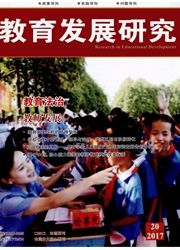

 中文摘要:
中文摘要:
利用财政转移支付中"差额补助"计算法的设计思想,结合我国流动儿童义务教育各流入城市之间的实际,构建对流动儿童义务教育财政转移支付量化分析的数学模型,并据此对全国十个主要流入地城市进行模拟。模拟结果显示,在十个城市中,无论经济发达与否,都可获得基本转移,其数额与综合权重系数有密切关系。地方政府能否获得差额转移支付与地方教育发达程度有很大关系。此外,对于流动儿童规模大,且跨省流动比例高的城市,中央政府的转移支付数额较大,这也与中央财政重点对跨省流动进行转移支付的思路是吻合的。因此,国家应尽快在财政转移支付制度中,统筹考虑大量流动人口跨地区、跨省向城市集中的趋势,对流入地城市进行流动儿童教育经费的转移支付,才能够达到提高公共财政利用效率和鼓励地方政府积极进行流动儿童义务教育投资的目的。
 英文摘要:
英文摘要:
On the basis of the design philosophy of "balance subsidy" numeration in financial transfer payments,the article puts forward a mathematical model of quantitative analysis in financial transfer payments on compulsory education funds of the migrant workers' children. Based on this model, the paper simulates computation on ten cities which are the primary irdlowing cities all over the country. Simulation result displays:with their economy developed or not, ten cities all can get basis transfer payments which are closely related to the weight coefficient. The amount of transfer payments from central government is larger to the cities which have large number of migrant workers' children and the high trans-provincial ratio. The paper advises the central government to transfer payment on inflowing cities in order to increase the efficiency of public finance and encourage the local government to invest on the education of the migrant workers' children.
 同期刊论文项目
同期刊论文项目
 同项目期刊论文
同项目期刊论文
 期刊信息
期刊信息
